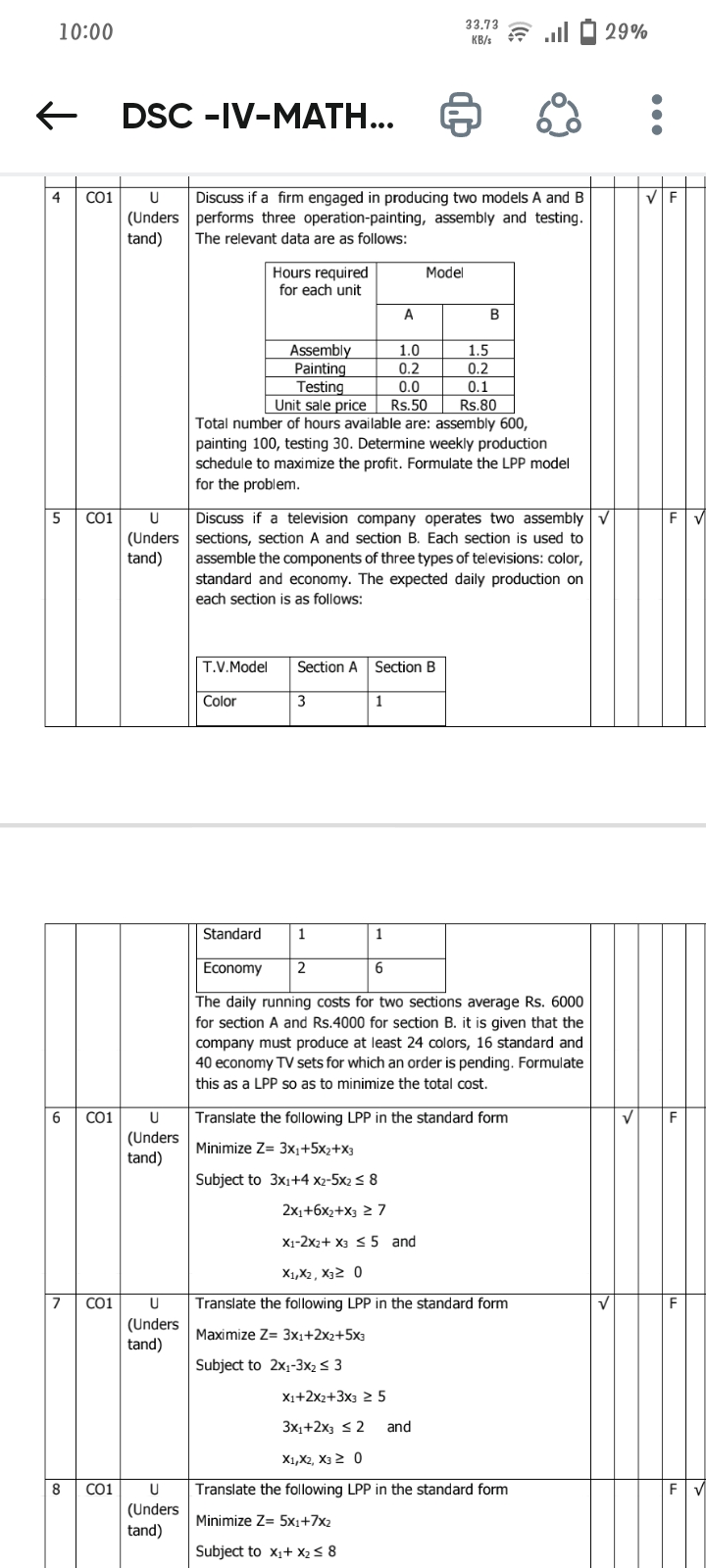Discuss if a firm engaged in producing two models A and B performs three operations: painting, assembly, and testing. The relevant data are as follows: Hours required for each unit... Discuss if a firm engaged in producing two models A and B performs three operations: painting, assembly, and testing. The relevant data are as follows: Hours required for each unit: Assembly: A 1.0, B 1.5; Painting: A 0.2, B 0.2; Testing: A 0.0, B 0.1; Unit sale price: A Rs.50, B Rs.80. Total number of hours available: assembly 600, painting 100, testing 30. Determine weekly production schedule to maximize profit. Formulate the LPP model for the problem.

Understand the Problem
The question is asking to discuss a firm producing two models A and B that engage in operations of painting, assembly, and testing, along with the necessary data to determine a weekly production schedule to maximize profit. It specifically requires formulating a linear programming problem (LPP) based on given constraints.
Answer
Maximize: $Z = 50x_1 + 80x_2$ subject to $1x_1 + 1.5x_2 \leq 600$, $0.2x_1 + 0.2x_2 \leq 100$, $0.1x_2 \leq 30$, and $x_1, x_2 \geq 0$.
Answer for screen readers
The LPP model is as follows:
Maximize:
$$ Z = 50x_1 + 80x_2 $$
Subject to:
$$ 1x_1 + 1.5x_2 \leq 600 $$
$$ 0.2x_1 + 0.2x_2 \leq 100 $$
$$ 0.1x_2 \leq 30 $$
$$ x_1, x_2 \geq 0 $$
Steps to Solve
- Define Variables
Let ( x_1 ) be the number of units of Model A produced
Let ( x_2 ) be the number of units of Model B produced
- Set Up the Objective Function
The objective is to maximize profit, which can be expressed as:
$$ Z = 50x_1 + 80x_2 $$
- Identify Constraints
The constraints based on hours required for each operation are:
-
Assembly constraint:
The assembly time for Model A is 1 hour per unit and for Model B is 1.5 hours per unit. Thus, the constraint is:
$$ 1x_1 + 1.5x_2 \leq 600 $$ -
Painting constraint:
The painting time for Model A is 0.2 hours per unit and for Model B is 0.2 hours per unit. Thus, the constraint is:
$$ 0.2x_1 + 0.2x_2 \leq 100 $$ -
Testing constraint:
The testing time for Model A is 0 hours per unit and for Model B is 0.1 hours per unit. Thus, the constraint is:
$$ 0x_1 + 0.1x_2 \leq 30 $$
- Non-negativity Constraints
Both quantities ( x_1 ) and ( x_2 ) must be non-negative:
$$ x_1 \geq 0 $$
$$ x_2 \geq 0 $$
- Compile the Linear Programming Model
Putting everything together, the Linear Programming Problem (LPP) can be summarized as:
Maximize:
$$ Z = 50x_1 + 80x_2 $$
Subject to:
$$ 1x_1 + 1.5x_2 \leq 600 $$
$$ 0.2x_1 + 0.2x_2 \leq 100 $$
$$ 0x_1 + 0.1x_2 \leq 30 $$
$$ x_1, x_2 \geq 0 $$
The LPP model is as follows:
Maximize:
$$ Z = 50x_1 + 80x_2 $$
Subject to:
$$ 1x_1 + 1.5x_2 \leq 600 $$
$$ 0.2x_1 + 0.2x_2 \leq 100 $$
$$ 0.1x_2 \leq 30 $$
$$ x_1, x_2 \geq 0 $$
More Information
This model can be solved using graphical methods or linear programming software. The solution will indicate the optimal number of each model to produce to maximize profits given the operational constraints.
Tips
- Neglecting to include all constraints.
- Incorrectly interpreting units of time required for each operation.
- Forgetting to specify non-negativity conditions for the variables.
AI-generated content may contain errors. Please verify critical information